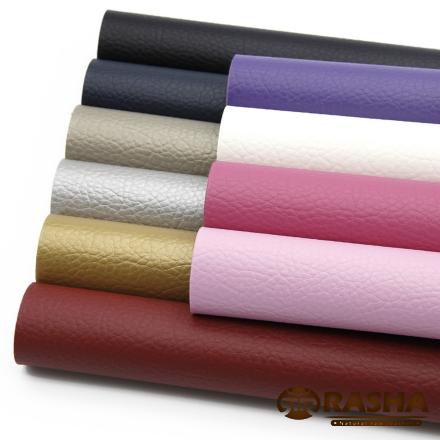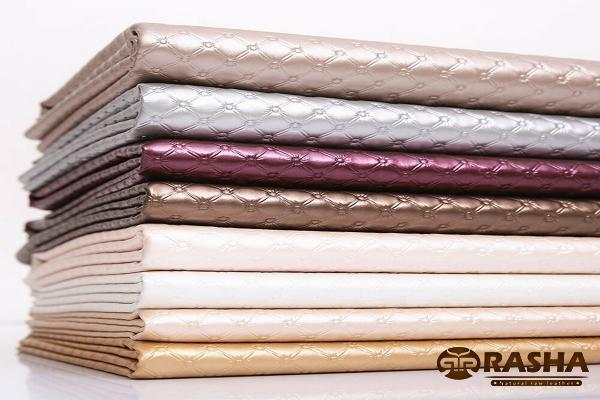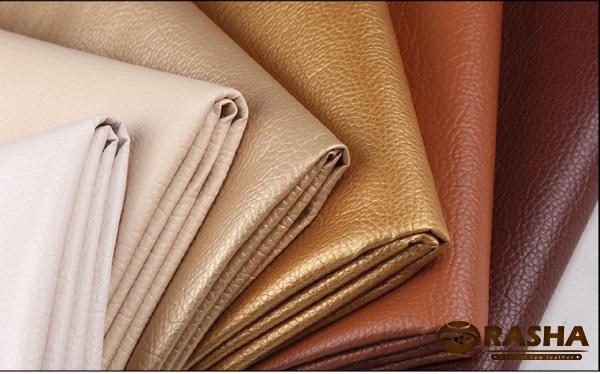Synthetic leather, also known as faux leather or artificial leather, is a popular material that has gained significant traction in various industries. With advancements in technology and increasing emphasis on sustainability, synthetic leather has emerged as a viable alternative to genuine leather. This summary explores the characteristics, production process, applications, and environmental advantages of synthetic leather. Understanding Synthetic Leather: Synthetic leather is a man-made material that replicates the appearance and texture of genuine leather. It is composed of a base fabric layer, which is coated or laminated with a synthetic material, typically polyvinyl chloride (PVC) or polyurethane (PU). This combination enhances the durability and flexibility of the material, making it suitable for a wide range of applications. Production Process: The production process of synthetic leather involves several stages. First, a fabric substrate, such as polyester or cotton, is treated with a coating of PVC or PU resins. The resins are then applied to the fabric using various techniques, including laminating, calendaring, or spraying. Afterward, the material is treated to achieve the desired texture, such as grain patterns or embossing, to resemble real leather. Finally, the material undergoes finishing processes, such as dyeing, printing, and coating, to enhance its aesthetic appeal and performance characteristics. Advantages of Synthetic Leather: 1. Cost-Effectiveness: Synthetic leather is generally more affordable than genuine leather. The production process allows for high-volume manufacturing, reducing overall production costs. 2. Wide Range of Colors and Textures: Synthetic leather offers a broad spectrum of colors and textures, providing designers and manufacturers with extensive options to suit different product requirements and consumer preferences. 3. Durability and Easy Maintenance: Synthetic leather is highly resistant to wear and tear, making it a more durable and long-lasting material than genuine leather. It is also easier to clean and maintain, as it does not absorb liquids or stains easily. 4. Animal-Free and Ethical: Synthetic leather provides an ethical alternative for consumers who are concerned about animal welfare. As it is a purely synthetic material, there is no involvement of animal products in its production. 5. Consistency: Unlike genuine leather, synthetic leather is manufactured and processed under controlled conditions, ensuring consistency in its appearance, texture, and quality.

leather
 Applications of Synthetic Leather: 1. Fashion and Apparel Industry: Synthetic leather finds widespread use in the fashion industry, particularly in the production of clothing, shoes, handbags, belts, and accessories. Its versatility allows for the creation of various styles and designs, catering to diverse fashion trends and consumer demands. 2. Automotive Industry: Synthetic leather is extensively used in the automotive sector, where it is employed for upholstery, seat covers, steering wheel covers, and interior trims. Its durability, easy maintenance, and wide range of colors make it an ideal choice for automotive applications. 3. Furniture and Interior Design: Synthetic leather has gained popularity in the furniture industry as an affordable alternative to genuine leather. It is used in the production of sofas, chairs, ottomans, and other upholstery applications. Its durability and aesthetic appeal make it a preferred choice for both residential and commercial spaces. 4. Electronic Devices and Accessories: With the proliferation of electronic devices, synthetic leather has found its way into the production of phone cases, laptop sleeves, tablet covers, and other accessories. Its protective qualities and customizable designs make it a popular choice among consumers. Environmental Advantages: In addition to its functional and aesthetic attributes, synthetic leather also offers several environmental advantages: 1. Reduced Animal Cruelty: By eliminating the need for animal products, synthetic leather contributes to a more humane approach to fashion and consumer goods manufacturing. 2. Conservation of Natural Resources: The production of synthetic leather requires fewer resources compared to genuine leather. It reduces the demand for raising livestock, which requires significant amounts of water, land, and feed. 3. Waste Reduction: Synthetic leather can be easily recycled and repurposed, reducing the accumulation of waste in landfills.
Applications of Synthetic Leather: 1. Fashion and Apparel Industry: Synthetic leather finds widespread use in the fashion industry, particularly in the production of clothing, shoes, handbags, belts, and accessories. Its versatility allows for the creation of various styles and designs, catering to diverse fashion trends and consumer demands. 2. Automotive Industry: Synthetic leather is extensively used in the automotive sector, where it is employed for upholstery, seat covers, steering wheel covers, and interior trims. Its durability, easy maintenance, and wide range of colors make it an ideal choice for automotive applications. 3. Furniture and Interior Design: Synthetic leather has gained popularity in the furniture industry as an affordable alternative to genuine leather. It is used in the production of sofas, chairs, ottomans, and other upholstery applications. Its durability and aesthetic appeal make it a preferred choice for both residential and commercial spaces. 4. Electronic Devices and Accessories: With the proliferation of electronic devices, synthetic leather has found its way into the production of phone cases, laptop sleeves, tablet covers, and other accessories. Its protective qualities and customizable designs make it a popular choice among consumers. Environmental Advantages: In addition to its functional and aesthetic attributes, synthetic leather also offers several environmental advantages: 1. Reduced Animal Cruelty: By eliminating the need for animal products, synthetic leather contributes to a more humane approach to fashion and consumer goods manufacturing. 2. Conservation of Natural Resources: The production of synthetic leather requires fewer resources compared to genuine leather. It reduces the demand for raising livestock, which requires significant amounts of water, land, and feed. 3. Waste Reduction: Synthetic leather can be easily recycled and repurposed, reducing the accumulation of waste in landfills.
Specifications of leather
 Additionally, advancements in green manufacturing techniques have resulted in the development of eco-friendly synthetic leather options made from recycled or bio-based materials. Conclusion: Synthetic leather has evolved into a viable and sustainable alternative to genuine leather, offering numerous advantages in terms of cost, versatility, durability, and ethics. Its consistent quality, customizable designs, and ease of maintenance make it a preferred choice for various industries, including fashion, automotive, furniture, and electronics. With its environmental benefits such as reducing animal cruelty and conservation of resources, synthetic leather demonstrates the potential to reshape the future of material options in a more sustainable and socially responsible manner. Synthetic Leather: An Innovative and Sustainable Alternative to Genuine Leather Introduction: Synthetic leather, also known as faux leather or artificial leather, is a popular material that has gained significant traction in various industries. With advancements in technology and increasing emphasis on sustainability, synthetic leather has emerged as a viable alternative to genuine leather. This article explores the characteristics, production process, applications, and environmental advantages of synthetic leather, highlighting its potential in the business realm. 1. Growing Demand and Market Potential: The global market for synthetic leather has experienced significant growth in recent years, driven by factors such as increasing consumer awareness of animal welfare, affordability, and environmental concerns. Market players in the synthetic leather industry are witnessing rising demand from segments such as fashion, automotive, furniture, and electronics. This presents a lucrative opportunity for businesses to tap into this growing market and cater to the changing preferences of customers. 2. Versatility and Customization: One of the main advantages of synthetic leather is its versatility and customization options. Unlike genuine leather, which is limited in terms of color and texture, synthetic leather offers a wide range of choices to suit various design requirements and consumer preferences. This flexibility allows businesses to create unique and innovative products that can stand out in the market. 3. Cost-effectiveness and Competitive Pricing: Synthetic leather is generally more affordable than genuine leather, making it an attractive option for businesses looking to reduce production costs and offer competitive pricing to customers. The production process of synthetic leather allows for high-volume manufacturing, resulting in economies of scale. As a result, businesses can achieve cost savings, maintain profitability, and offer products at price points that cater to a wider consumer base. 4. Enhanced Durability and Performance: Synthetic leather is highly durable and resistant to wear and tear, making it a long-lasting material for various applications. Unlike genuine leather, synthetic leather does not crack or fade easily, and it retains its shape and appearance over time. This durability translates into increased customer satisfaction, reduced maintenance costs, and a more positive brand reputation in the market. 5. Easy Maintenance and Performance Consistency: Synthetic leather is relatively low-maintenance compared to genuine leather. It is resistant to stains and can be easily cleaned with mild soap and water. This ease of maintenance is particularly beneficial for businesses in industries such as fashion, automotive, and furniture, where products are subjected to regular use and exposure to external elements. 6. Ethical Considerations and Consumer Preferences: The growing awareness and concern for animal welfare have led to an increasing number of consumers seeking alternatives to products made from animal hides.
Additionally, advancements in green manufacturing techniques have resulted in the development of eco-friendly synthetic leather options made from recycled or bio-based materials. Conclusion: Synthetic leather has evolved into a viable and sustainable alternative to genuine leather, offering numerous advantages in terms of cost, versatility, durability, and ethics. Its consistent quality, customizable designs, and ease of maintenance make it a preferred choice for various industries, including fashion, automotive, furniture, and electronics. With its environmental benefits such as reducing animal cruelty and conservation of resources, synthetic leather demonstrates the potential to reshape the future of material options in a more sustainable and socially responsible manner. Synthetic Leather: An Innovative and Sustainable Alternative to Genuine Leather Introduction: Synthetic leather, also known as faux leather or artificial leather, is a popular material that has gained significant traction in various industries. With advancements in technology and increasing emphasis on sustainability, synthetic leather has emerged as a viable alternative to genuine leather. This article explores the characteristics, production process, applications, and environmental advantages of synthetic leather, highlighting its potential in the business realm. 1. Growing Demand and Market Potential: The global market for synthetic leather has experienced significant growth in recent years, driven by factors such as increasing consumer awareness of animal welfare, affordability, and environmental concerns. Market players in the synthetic leather industry are witnessing rising demand from segments such as fashion, automotive, furniture, and electronics. This presents a lucrative opportunity for businesses to tap into this growing market and cater to the changing preferences of customers. 2. Versatility and Customization: One of the main advantages of synthetic leather is its versatility and customization options. Unlike genuine leather, which is limited in terms of color and texture, synthetic leather offers a wide range of choices to suit various design requirements and consumer preferences. This flexibility allows businesses to create unique and innovative products that can stand out in the market. 3. Cost-effectiveness and Competitive Pricing: Synthetic leather is generally more affordable than genuine leather, making it an attractive option for businesses looking to reduce production costs and offer competitive pricing to customers. The production process of synthetic leather allows for high-volume manufacturing, resulting in economies of scale. As a result, businesses can achieve cost savings, maintain profitability, and offer products at price points that cater to a wider consumer base. 4. Enhanced Durability and Performance: Synthetic leather is highly durable and resistant to wear and tear, making it a long-lasting material for various applications. Unlike genuine leather, synthetic leather does not crack or fade easily, and it retains its shape and appearance over time. This durability translates into increased customer satisfaction, reduced maintenance costs, and a more positive brand reputation in the market. 5. Easy Maintenance and Performance Consistency: Synthetic leather is relatively low-maintenance compared to genuine leather. It is resistant to stains and can be easily cleaned with mild soap and water. This ease of maintenance is particularly beneficial for businesses in industries such as fashion, automotive, and furniture, where products are subjected to regular use and exposure to external elements. 6. Ethical Considerations and Consumer Preferences: The growing awareness and concern for animal welfare have led to an increasing number of consumers seeking alternatives to products made from animal hides.
buy leather
 Synthetic leather provides a cruelty-free option, appealing to a significant segment of conscious consumers who prioritize ethical fashion and sustainable choices. By offering synthetic leather products, businesses can align themselves with changing consumer preferences and contribute to a more ethical and sustainable supply chain. 7. Brand Differentiation and Innovation: In a competitive business landscape, offering synthetic leather products can provide a unique selling point and help businesses differentiate themselves from competitors. By incorporating synthetic leather into their product portfolios, companies can showcase their commitment to innovation, sustainability, and meeting evolving consumer demands. This can lead to increased brand loyalty, customer retention, and positive word-of-mouth recommendations. 8. Shift Towards Sustainable Materials: With growing concerns about climate change and environmental impact, businesses across industries are actively seeking ways to adopt more sustainable practices. By utilizing synthetic leather, companies can reduce their reliance on genuine leather, which has a significant environmental footprint due to livestock farming and chemical-intensive tanning processes. Embracing synthetic leather as a sustainable alternative enables businesses to align their operations with corporate social responsibility goals and attract sustainability-conscious consumers. 9. Collaboration Opportunities: The synthetic leather industry offers collaboration opportunities between businesses from different sectors. For example, fashion brands can partner with automotive manufacturers to develop innovative solutions for interior upholstery in vehicles. Similarly, partnerships between furniture manufacturers and electronic device companies can explore new applications for synthetic leather in the production of smart home products. Collaboration enables businesses to leverage their expertise, expand their reach, and tap into new customer segments. 10. Technological Advancements and Research: The development of synthetic leather has been accompanied by significant advancements in technology and ongoing research. Businesses that invest in research and development can stay at the forefront of innovation, constantly improving the quality, performance, and sustainability of synthetic leather products. By being proactive in adapting to new technologies and materials, companies can position themselves as industry leaders and gain a competitive edge. Conclusion: Synthetic leather offers businesses a range of benefits, including cost-effectiveness, customization options, enhanced durability, and ethical considerations. Its versatility and low-maintenance nature make it suitable for a wide array of applications in industries such as fashion, automotive, furniture, and electronics. Furthermore, synthetic leather aligns with the growing demand for sustainable materials, providing businesses with an opportunity to meet the changing preferences of environmentally conscious consumers. By embracing synthetic leather, businesses can differentiate themselves in the market, foster innovation and collaboration, and contribute to a more sustainable and ethical future.
Synthetic leather provides a cruelty-free option, appealing to a significant segment of conscious consumers who prioritize ethical fashion and sustainable choices. By offering synthetic leather products, businesses can align themselves with changing consumer preferences and contribute to a more ethical and sustainable supply chain. 7. Brand Differentiation and Innovation: In a competitive business landscape, offering synthetic leather products can provide a unique selling point and help businesses differentiate themselves from competitors. By incorporating synthetic leather into their product portfolios, companies can showcase their commitment to innovation, sustainability, and meeting evolving consumer demands. This can lead to increased brand loyalty, customer retention, and positive word-of-mouth recommendations. 8. Shift Towards Sustainable Materials: With growing concerns about climate change and environmental impact, businesses across industries are actively seeking ways to adopt more sustainable practices. By utilizing synthetic leather, companies can reduce their reliance on genuine leather, which has a significant environmental footprint due to livestock farming and chemical-intensive tanning processes. Embracing synthetic leather as a sustainable alternative enables businesses to align their operations with corporate social responsibility goals and attract sustainability-conscious consumers. 9. Collaboration Opportunities: The synthetic leather industry offers collaboration opportunities between businesses from different sectors. For example, fashion brands can partner with automotive manufacturers to develop innovative solutions for interior upholstery in vehicles. Similarly, partnerships between furniture manufacturers and electronic device companies can explore new applications for synthetic leather in the production of smart home products. Collaboration enables businesses to leverage their expertise, expand their reach, and tap into new customer segments. 10. Technological Advancements and Research: The development of synthetic leather has been accompanied by significant advancements in technology and ongoing research. Businesses that invest in research and development can stay at the forefront of innovation, constantly improving the quality, performance, and sustainability of synthetic leather products. By being proactive in adapting to new technologies and materials, companies can position themselves as industry leaders and gain a competitive edge. Conclusion: Synthetic leather offers businesses a range of benefits, including cost-effectiveness, customization options, enhanced durability, and ethical considerations. Its versatility and low-maintenance nature make it suitable for a wide array of applications in industries such as fashion, automotive, furniture, and electronics. Furthermore, synthetic leather aligns with the growing demand for sustainable materials, providing businesses with an opportunity to meet the changing preferences of environmentally conscious consumers. By embracing synthetic leather, businesses can differentiate themselves in the market, foster innovation and collaboration, and contribute to a more sustainable and ethical future.










Your comment submitted.